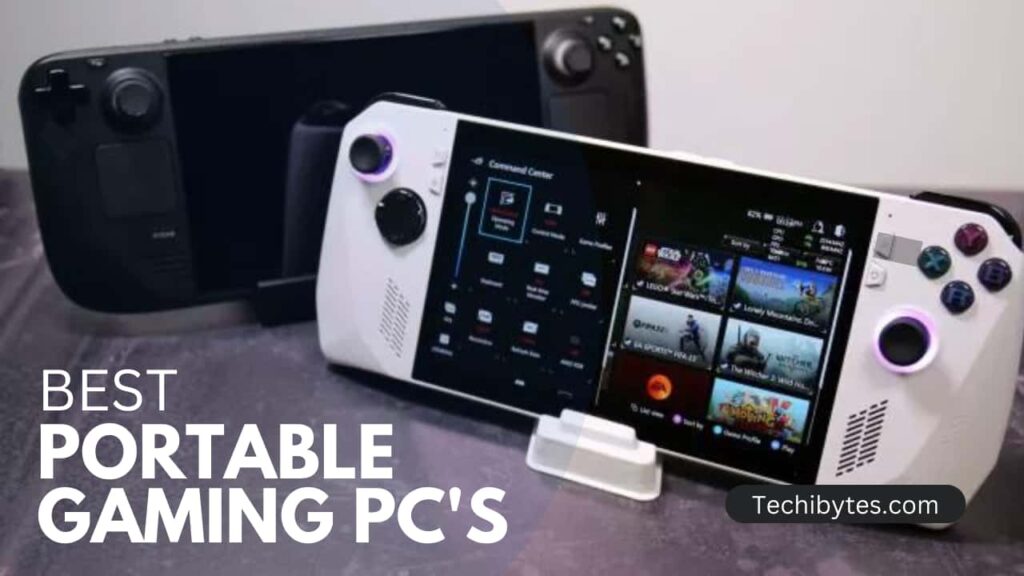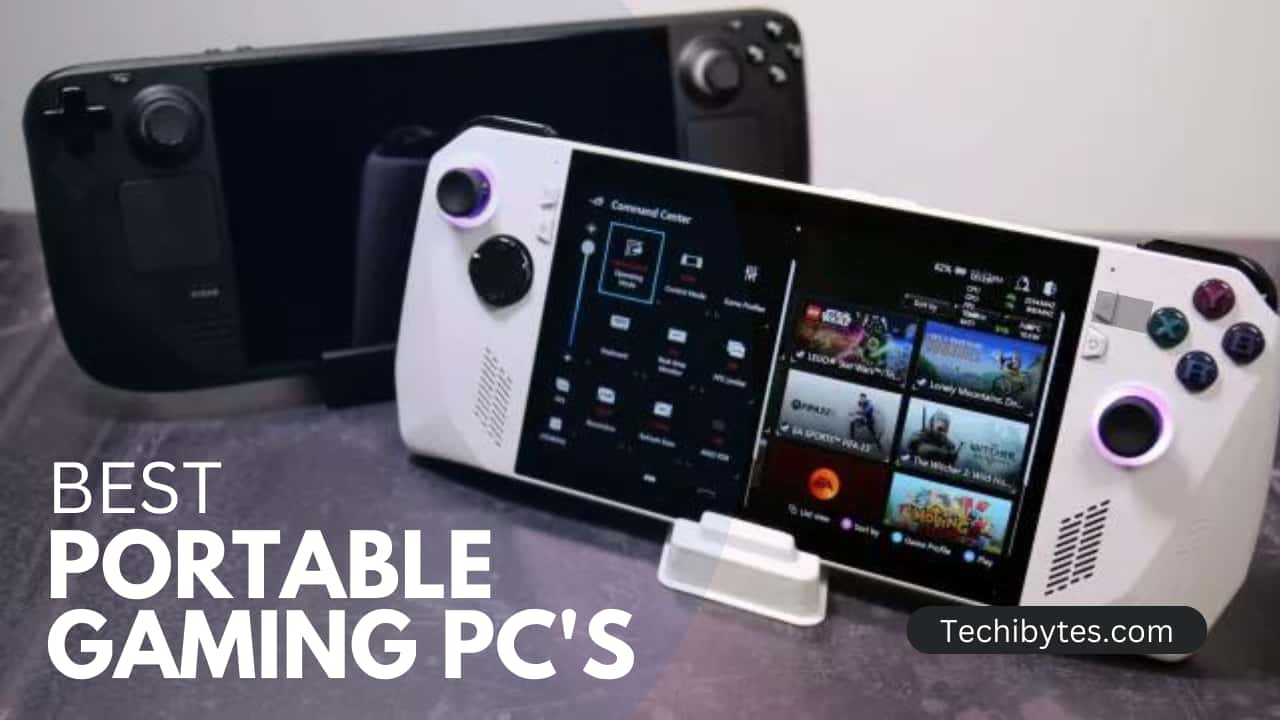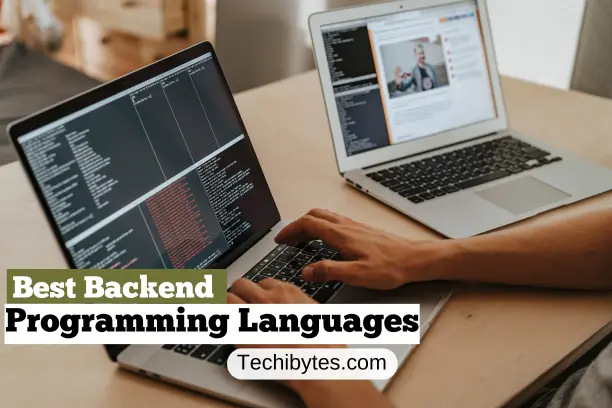The phrase “portable gaming PC” would have been absurd a decade or so ago, but here we are today. Within a few short years, gaming PCs have evolved from bulky machines to tiny handheld devices you can fit into your pocket!
Now that we’ve established that the time is right to have the portable gaming PC discussion, we can get to the main question of the day: what’s the best portable gaming PC out there for enthusiasts?
Before answering that question, however, it’s essential to define some terms to ensure we’re on the same page about the meaning of a ‘portable’ gaming PC.
Table of Contents
What is a Portable Gaming PC?
The meaning of a portable PC has changed slowly over the past few generations. A few years ago, portable PCs exclusively meant laptops, and that description is not incorrect, even for 2023.
However, most people have learned to differentiate between PCs and laptops, and when they need recommendations for the latter, they simply ask for laptops. So, people asking for portable gaming PCs want a new type of hardware that’s portable, runs PC software, and is powerful enough to play games.
Long story short, portable gaming PCs refer to a new category of devices that combine every component you need for gaming in a tablet-sized package.
They come in many forms—from the Steam Deck, which uses a Nintendo Switch-like design, to the GPD Win Max, which uses a design that we have no idea what it looks like.
So, this compilation will focus on this new category of devices and show you the best portable gaming PCs in 2023 for all needs and budgets.

Best Portable Gaming PCs
1. Steam Deck
Steam Deck deserves accolades for being the first device to popularize the idea of a portable handheld gaming device that runs a full-fledged desktop operating system. As its name implies, the device is from Steam, the cross-platform digital game distribution service owned by Valve.
The device comes in a Nintendo Switch-like handheld format with buttons and a mini touchpad that lets you navigate around the OS.
While it comes with Linux by default, members of the gaming community have successfully hacked Windows onto the device, exploring its possibilities beyond the handful of Steam games that run natively on Linux.
The Steam Deck comes with an AMD Zen 2 APU, including a quad-core CPU and an eight-core GPU, supported by 16 GB of DDR4 RAM.
It uses a relatively low-resolution display with 1280 x 800 pixels, but it’s plenty sharp for the device’s seven-inch display. With up to 512 GB of onboard SSD storage, the Steam Deck is one of the best portable gaming PCs on the market right now.
2. Ayaneo 2
Ayaneo specializes in making handheld portable gaming PCs, and the Ayaneo 2 is its ultimate bang-for-the-buck flagship device.
The device comes in a similar design as the Steam Deck and features a similar seven-inch display, but is available in both 16 and 32 GB RAM variants, unlike the Steam Deck, which is only available in 16 GB.
You can configure it with up to 2 Terabytes of SSD storage, and the device runs Windows 11 out of the box. It also uses an eight-core Ryzen 7 6800U from AMD that runs circles around the processor in the Steam Deck.
However, the Ayaneo 2 is by no means an affordable device. It starts at $1,100 for the base model, which is about three times as expensive as the Steam Deck, a device that starts at $359.
3. ONEXPLAYER
The ONEXPLAYER is an absolute performance monster capable of running pretty much anything you throw at it, thanks to its highly performant Intel Core i5 or i7 processor. ONEXPLAYER features two fans to dissipate the inevitable heat output from the Intel processors when the going gets tough.
The device is not small, as it features a massive 8.4-inch touch-screen display that makes it significantly bigger than the Aya Neo 2 and the Steam Deck.
It comes with a built-in kickstand, a Micro SD card slot, a USB C port, and Thunderbolt 4 ports that make it possible to connect to an external display. At $1,200, it’s possibly the most expensive portable gaming PC on this list, if you agree that behemoth is portable.
4. AYN Odin
Emulator junkies already know AYN Odin isn’t exactly built for PC gaming, but hear me out: this device is possibly the best cheap portable gaming PC for gamers not seeking 60 fps on all AAA games.
To understand a bit more about this device, it was initially designed to run games within emulators, and for that, it features a 2.0 GHz Dimensity D100G CPU and up to 8 GB of RAM.
Those specs play nicely with Sega Saturn emulators, but you can also sideload Windows onto your Odin, making it a nice little device for those retro PC games that don’t require tons of cores or terabytes of RAM. With its sub-$200 price tag, the AYN Odin is hard to beat as far as cheap retro portable gaming PCs are concerned.
5. GPD Win Max
The GPD Win Max is a pretty strange one, as it features a fully functional keyboard along with a portable gaming PC package. It looks more like a PSP Go than a regular PSP, but rather than have controllers on the bottom, that’s a keyboard complete with function keys and all.
Of course, it’s not a full-sized keyboard; it’s only usable by holding the device with both hands and pecking at keys with your thumbs. However, if you find yourself having to type often in your ideal usage of this device, having that should be insanely useful.
Talking of specs, it uses a 10th-gen Intel Core i5 processor with an Iris Plus 940 GPU. It also ships with a large 8-inch touchscreen display with a 1280 x 800-pixel resolution, an HDMI port for hooking it up to an external monitor, a large battery, and, of course, a built-in keyboard. There are also gaming controllers and a tiny trackpad atop the keyboard, making it an excellent portable gaming PC.
6. ONEXPLAYER Mini
One of the biggest criticisms of the ONEXPLAYER is its size; 8.4 inches is already scratching the roof of what’s considered ‘portable,’ and the weight makes it heavier than most people would carry in their backpacks.
ONEXPLAYER’s response to that is the ONEXPLAYER Mini, a device that shrinks its bigger brother down to make it more pocketable and, hence, portable.
The PC uses a 7-inch display that’s in the same ballpark as the Aya Neo 2 and the Steam Deck, and it exclusively uses AMD Zen 3 processors that require less beefy cooling systems than Intel Core processors.
You can configure it with up to 2TB of storage and 16 GB of RAM, making it a monster of a handheld gaming PC.
While it isn’t as powerful as, say, a gaming laptop or even the regular ONEXPLAYER, it can play most of your favorite AAA games at acceptable frame rates. For a device that fits into your pocket, that’s more than sufficient.
7. Ayaneo Air
Described as the “Switch Lite of handheld gaming PCs” by gaming publication IGN, the Ayaneo Air has an important role in the portable gaming PC market.
Looking at competitors like the Steam Deck and even the Ayaneo 2 from the same company, one can’t help but wonder how they qualify as portable with their bulk and unpocketable size.
As expected, the Ayaneo Air pushes the limit of how small a handheld gaming PC can be, only being slightly larger than the Nintendo Switch Lite. However, you can’t shrink a portable gaming PC that much without some blow to performance and gaming experience, and the blows here are apparent from the specs.
For one, the Ayaneo Air comes with a 5.5-inch AMOLED touchscreen, the same tiny screen size as the Switch Lite. However, the screen packs a 1080p resolution, which is a plus for the device.
It also comes with a six-core Ryzen 5 or eight-core Ryzen 7 APU, up to 32GB of RAM, and up to 2TB of fast NVMe SSD. At $499 for the base model, the Ayaneo Air is a suitable competitor to the insanely popular Switch Deck.
8. ASUS ROG Ally
As long as the discussion is about gaming, you should expect to see ASUS with its impressive ROG line. For portable gaming PCs, the ASUS ROG Ally is the company’s flagship, and compared to similar devices, its performance and flexibility are almost second-to-none.
It comes with a Ryzen Z1 Extreme SOC with RDNA 3 graphics, 512 GB of NVMe storage, and 16GB of LPDDR5 RAM. The ROG Ally also uses a 7-inch 1080p screen with a 120Hz refresh rate, making it one of the most beautiful screens on a handheld device.
Looks should be subjective, but I think we can all agree when I say the ASUS ROG Ally has the most beautiful body of any portable gaming PC on this list.
The ROG Ally comes with Windows 11 out of the box, and that’s a big deal because, unlike with the Steam Deck, your game selection is a lot wider than Steam.
However, since Windows isn’t exactly designed for that kind of device, you should expect some bugs with this device. Overall, it’s a decent gaming package for the $600 price tag.
Conclusion
Ten years ago, fitting a processor capable of gaming into a handheld device was inconceivable. Today, the market is awash with tens of these devices, offering you portable gaming for an insanely affordable price. This article lists the best portable gaming PCs for 2023, their specs, and how much they cost.
If you liked this article, then please subscribe to our YouTube Channel for videos relating to this article. You can also find us on Twitter and Facebook.
FAQs
What is the best handheld gaming console?
The answer depends on what kind of games you’re looking to play. If you’re setting your sights on traditional console games, the Nintendo Switch is pretty much your only option, but for PC games, there’s a wide variety, with the ASUS ROG Ally and the Steam Deck being the best all-around options.
Can a gaming PC be portable?
A couple of years ago, the answer to this question would have been no, but times have changed. Now that we have the GPD devices, the Steam Deck, and the ROG Ally, it would be ingenious to suggest a gaming PC cannot be portable.










